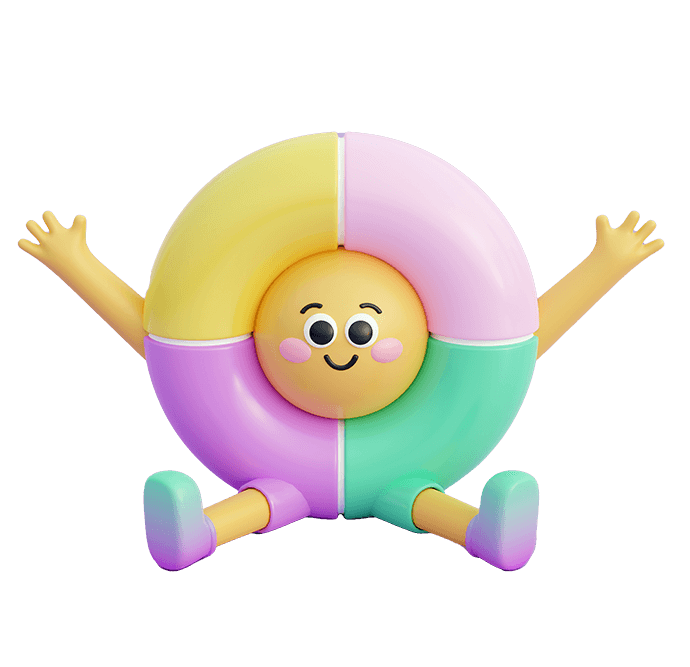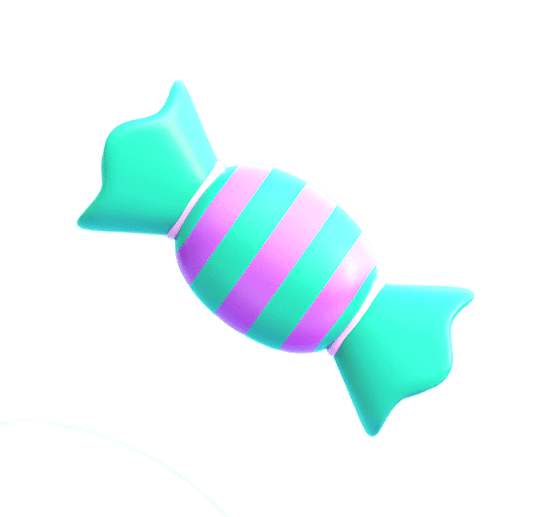Stuffed animals are more than just toys; they are companions that offer comfort, warmth, and joy. However, over time, they can accumulate dust, dirt, and even stains, making it essential to give them a good cleaning. You might be wondering: what’s the best way to clean these beloved plush toys without damaging them? Well, you’ve come to the right place. In this guide, we’ll cover everything you need to know about cleaning stuffed animals, from machine washing to air drying, and share some helpful tips to keep your stuffed animals looking as good as new.
Cleaning stuffed animals can be done in various ways, depending on the material and size. Whether machine washing, hand washing, or spot cleaning, the key is using the right method to protect the fabric and stuffing. Regular maintenance can also help extend the life of your plush toys.
Let’s dive into the details and learn how to keep your stuffed animals fresh, clean, and cuddly for years to come!
1. What Are the Best Methods for Cleaning Stuffed Animals?

When it comes to cleaning stuffed animals, the best method depends on the type of fabric and the level of dirtiness. Some toys are durable and can handle a machine wash, while others require a gentler approach.
The most common cleaning methods for stuffed animals include machine washing, hand washing, and spot cleaning. The method you choose will depend on the toy’s fabric and condition.
Machine Washing:
For most durable stuffed animals, like those made from cotton or polyester, machine washing is the fastest and easiest method. However, to prevent any damage, it’s important to protect the stuffed animal by placing it in a mesh laundry bag. A gentle cycle with cold water is best to preserve the toy’s fabric and shape.
Hand Washing:
For more delicate or smaller toys, hand washing is the safest option. Fill a basin with warm water and a mild detergent. Gently agitate the water and use a soft cloth or sponge to clean the toy. Be careful not to scrub too hard to avoid damaging the fabric.
Limpieza de manchas:
If your stuffed animal only has small areas of dirt or stains, spot cleaning is a great choice. Use a damp cloth with mild soap or a fabric cleaner to gently clean the soiled area. This method is ideal for toys that don’t need a full wash and helps maintain the toy’s overall condition.
| Cleaning Method | Lo mejor para | Key Steps | Notes |
|---|---|---|---|
| Machine Washing | Durable stuffed animals (cotton, polyester) | Place toy in a mesh laundry bag, use gentle cycle with cold water. | Protects fabric and shape; fastest method. |
| Hand Washing | Delicate, small, or older stuffed animals | Use warm water and mild detergent; gently clean with a soft cloth or sponge. | Safest for fragile fabrics; avoid harsh scrubbing. |
| Limpieza de manchas | Light dirt or small stains | Dampen cloth with mild soap or fabric cleaner; gently wipe stained areas. | Ideal for preserving toys that don’t need full washing. |
2. How to Wash Stuffed Animals in a Washing Machine?

Washing stuffed animals in a machine can save you time, but it’s important to follow the correct procedure to avoid damaging them. Here’s how you can safely clean stuffed animals in the washing machine.
When washing stuffed animals in the machine, it’s crucial to use the correct settings, like cold water and a gentle cycle, and to place the toy in a mesh laundry bag to protect it during the wash.
Step-by-Step Guide:
- Prepare the Toy: Check the care label first to ensure that the stuffed animal is machine washable. Secure any removable parts, like buttons or eyes, to prevent them from falling off during the wash.
- Use a Mesh Laundry Bag: Always place the stuffed animal in a mesh laundry bag. This helps reduce friction during the wash and keeps the toy from getting damaged or losing its shape.
- Choose Gentle Settings: Set your washing machine to a gentle or delicate cycle and use cold water. Hot water can cause shrinkage and damage the fabric or stuffing.
- Drying: After washing, avoid using the dryer, as high heat can damage the fabric and stuffing. Instead, lay the stuffed animal flat on a towel to air dry, reshaping it as needed.
Tips for Large Stuffed Animals:
For large stuffed animals, like teddy bears or body pillows, you may need to use an industrial-size washer at a laundromat. Always use a pillowcase or laundry bag to protect them during the wash.
| Step/Aspect | Acciones y consideraciones clave | Notes |
|---|---|---|
| Prepare the Toy | Check care label; secure removable parts like buttons or eyes. | Ensure the toy is machine washable before proceeding. |
| Use a Mesh Laundry Bag | Place the stuffed animal inside a mesh bag to reduce friction and damage. | Helps maintain shape and protects delicate features. |
| Choose Gentle Settings | Use a gentle or delicate cycle with cold water. | Avoid hot water to prevent shrinkage and fabric damage. |
| Drying Method | Air dry the toy flat on a towel; reshape as needed. | Do not use a dryer; high heat can damage stuffing and fabric. |
| Tips for Large Stuffed Animals | Use an industrial washer and protect the toy with a pillowcase or laundry bag. | Better suited for oversized toys like large teddy bears. |
3. What Is the Best Way to Clean Delicate or Vintage Stuffed Animals?
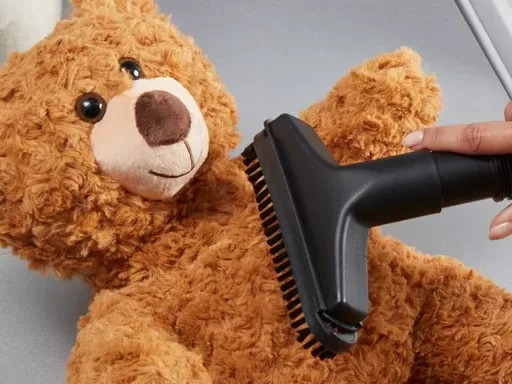
Delicate or vintage stuffed animals require extra care when cleaning. Many older toys are made from fragile fabrics, such as velvet or silk, and have intricate details that could be easily damaged by harsh cleaning methods.
Hand washing is usually the safest method for cleaning delicate or vintage stuffed animals. Use mild detergents, avoid excessive water, and air dry the toys to preserve their shape and condition.
Hand Washing Delicate Toys:
For delicate or vintage stuffed animals, hand washing is the safest option. Fill a basin with cool water and mild detergent. Gently submerge the toy and agitate the water with your hands to loosen dirt. Use a soft cloth to blot away stains, but avoid scrubbing too hard to prevent fabric damage.
Fabric Cleaner:
For vintage stuffed animals, consider using a fabric cleaner made for delicate materials. These products are specifically designed to be gentle on older fabrics while still being effective at removing stains. Always spot-test the cleaner on a small, inconspicuous area before applying it to the whole toy.
Drying Techniques:
After cleaning, allow the stuffed animal to air dry naturally. Never place it in the dryer, as the heat can damage both the fabric and the stuffing. Instead, lay the toy on a towel and gently reshape it as it dries.
| Step/Method | Best Practices | Important Notes |
|---|---|---|
| Hand Washing | Use cool water and mild detergent; gently agitate and blot stains without scrubbing. | Safest method to protect fragile or vintage fabrics. |
| Use of Fabric Cleaner | Choose cleaners designed for delicate materials; spot-test before full application. | Avoid harsh chemicals that could damage older or sensitive fabrics. |
| Drying Techniques | Air dry naturally on a towel; gently reshape the toy while drying. | Never use a dryer—heat can damage fabric and stuffing. |
4. Are There Any Risks When Cleaning Stuffed Animals?
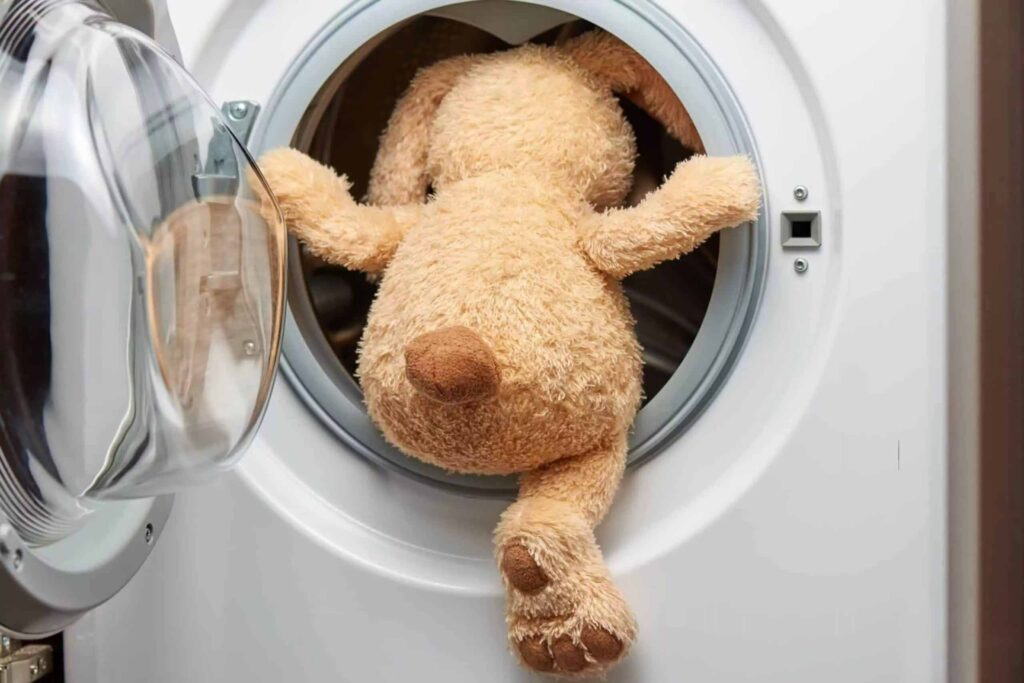
Cleaning stuffed animals is important, but there are potential risks if not done properly. Using harsh chemicals or washing too aggressively can damage the toy’s fabric, cause stuffing to clump, or even result in the loss of intricate details.
Cleaning stuffed animals improperly can cause fabric damage, loss of stuffing, or color fading. It’s important to use the right cleaning method and products to ensure the toy remains in good condition.
Fabric Damage:
Using harsh detergents or hot water can cause fabric shrinkage, fading, or even tears. Always use a mild detergent and wash in cold water to preserve the fabric’s color and texture. For vintage toys, opt for specialized fabric cleaners to ensure the material isn’t damaged.
Stuffing Clumping:
High heat, aggressive washing, or excessive moisture can cause the stuffing inside a stuffed animal to clump together, ruining its shape. To avoid this, air dry your stuffed animal rather than using a dryer, and be gentle when washing.
Color Fading:
Some stuffed animals are dyed with vibrant colors that may fade over time. To prevent this, always wash toys in cold water and use detergents that are safe for colored fabrics. If you’re concerned about color fading, consider spot cleaning instead of a full wash.
| Risk Factor | Potential Problem | How to Prevent It |
|---|---|---|
| Fabric Damage | Shrinkage, fading, or tearing due to harsh detergents or hot water. | Use mild detergent and wash with cold water; choose gentle cleaners for vintage toys. |
| Stuffing Clumping | Loss of shape from high heat, rough washing, or excess moisture. | Air dry instead of using a dryer; handle gently during washing. |
| Color Fading | Colors may fade, especially on vibrantly dyed toys. | Wash in cold water with color-safe detergent; consider spot cleaning for delicate colors. |
5. How Do You Dry Stuffed Animals After Cleaning?
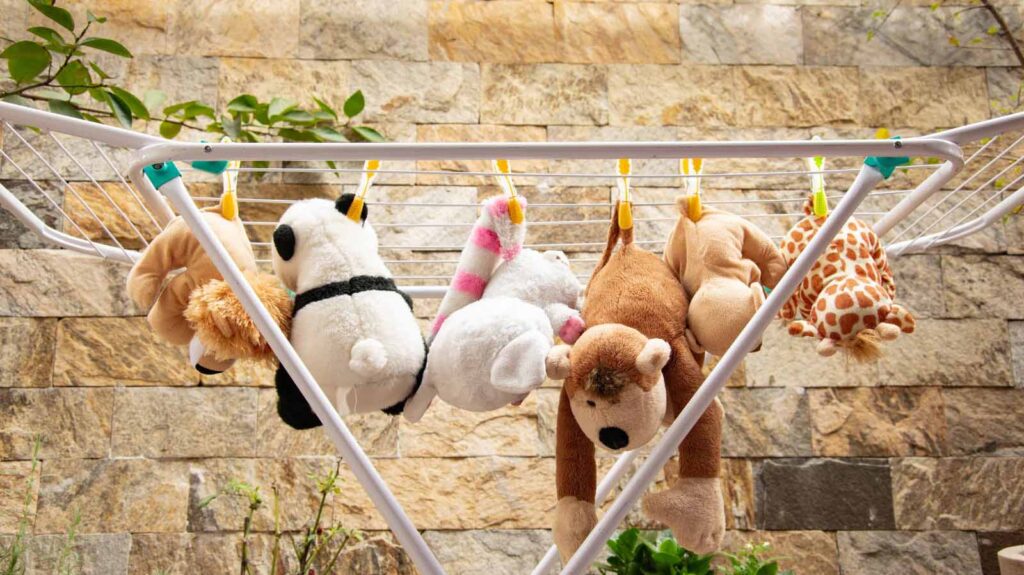
Drying is just as important as washing when it comes to maintaining the condition of your stuffed animals. Improper drying can lead to misshapen toys, clumped stuffing, or fabric damage.
The best way to dry stuffed animals is to air dry them. Avoid tumble drying, especially on high heat, as this can cause damage. Gently reshape the toy as it dries to maintain its original form.
Air Drying:
After washing, the safest way to dry stuffed animals is to air dry them. Lay the toy flat on a clean towel, making sure it’s reshaped properly. Avoid direct sunlight, as it can cause the fabric to fade. For larger toys, you can hang them up to dry.
Tumble Drying:
If you choose to tumble dry your stuffed animal, make sure to set the dryer to the lowest heat setting. High heat can damage the fabric and stuffing, so it’s better to air dry whenever possible. Remove the toy from the dryer as soon as it’s dry to prevent over-drying.
Use of Fans:
To speed up the drying process without using heat, consider using a fan to circulate air around the stuffed animal. This will help the toy dry faster without the risk of heat damage.
| Drying Method | Acciones y consideraciones clave | Important Notes |
|---|---|---|
| Air Drying | Lay the stuffed animal flat on a clean towel; reshape during drying. | Avoid direct sunlight to prevent fabric fading. |
| Tumble Drying | Use the lowest heat setting if necessary; remove as soon as dry. | High heat can damage fabric and stuffing—air drying is preferred. |
| Use of Fans | Position a fan to circulate air around the toy to speed up drying. | Speeds drying without heat damage; great alternative to dryers. |
6. What Products Should You Use to Clean Stuffed Animals Safely?
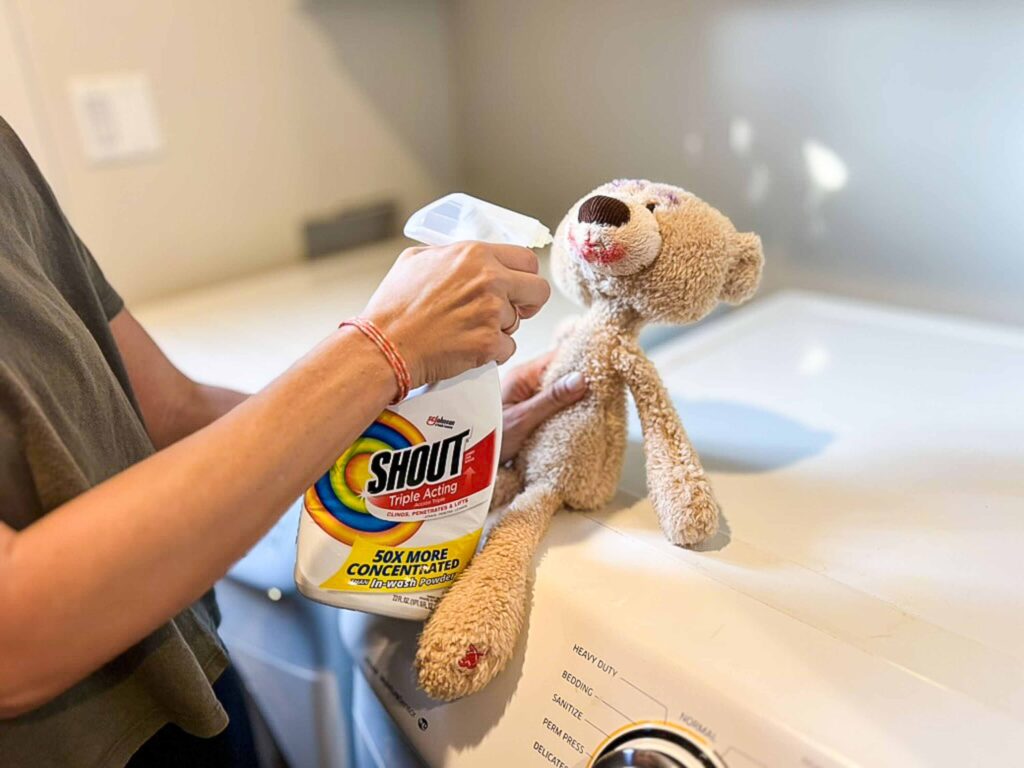
When cleaning stuffed animals, it’s important to use products that won’t damage the fabric or stuffing. Harsh chemicals or strong detergents can cause the toy to lose its softness or shape.
Use mild detergents, fabric cleaners, and spot cleaners that are specifically designed for plush toys. Non-toxic, hypoallergenic, and eco-friendly options are best for children’s toys.
Mild Detergents:
Always opt for a mild, gentle detergent that is free of harsh chemicals. Look for products that are hypoallergenic and fragrance-free, especially if the stuffed animal is for a child.
Fabric Cleaners:
For deep cleaning, you can use fabric cleaners designed for plush toys. These cleaners are often milder than standard laundry detergents and help remove stains without damaging the fabric. Always check that the product is safe for the specific material of your stuffed animal.
Eco-Friendly Options:
If you’re looking for a more eco-friendly cleaning solution, there are many biodegradable detergents and cleaners available. These are gentle on the environment and still effective at cleaning your stuffed animals without harmful chemicals.
| Product Type | Best Use | Important Notes |
|---|---|---|
| Mild Detergents | General washing of stuffed animals. | Choose hypoallergenic, fragrance-free detergents to protect fabric and sensitive skin. |
| Fabric Cleaners | Deep cleaning and stain removal for delicate plush toys. | Ensure the cleaner is suitable for plush materials; spot-test before full use. |
| Eco-Friendly Options | Environmentally conscious cleaning for stuffed animals. | Look for biodegradable, non-toxic formulas for safe and effective cleaning. |
7. How to Keep Stuffed Animals Clean Between Washes?
Regular maintenance can reduce the need for frequent washes and help keep stuffed animals looking fresh. Here are some tips to keep them clean between deep cleanings.
Regular maintenance, such as spot cleaning, proper storage, and airing out, can keep your stuffed animals clean between washes.
Limpieza de manchas:
For minor stains, use a damp cloth and mild detergent to spot clean the affected area. This is a great way to keep your stuffed animals looking fresh without the need for a full wash.
Storage:
Proper storage is essential to keep your stuffed animals clean. Store them in a dry, clean place where they are not exposed to dust or dirt. A toy bin or hanging them in a closet is a good option.
Airing Out:
Every once in a while, hang your stuffed animal in a well-ventilated area to air it out. This helps remove any odors and keeps the fabric fresh.
| Maintenance Method | Acciones y consideraciones clave | Benefits |
|---|---|---|
| Limpieza de manchas | Use a damp cloth and mild detergent to clean minor stains. | Keeps stuffed animals fresh without full washing. |
| Proper Storage | Store in a clean, dry place like a toy bin or closet to avoid dust and dirt. | Reduces dirt buildup and protects fabric integrity. |
| Airing Out | Hang in a well-ventilated area occasionally to remove odors. | Helps maintain a fresh, clean smell between washes. |
Conclusión
Cleaning stuffed animals is not as complicated as it may seem. With the right methods, tools, and products, you can keep your plush toys clean, fresh, and in excellent condition for years to come. Whether you’re hand washing, machine washing, or spot cleaning, the key is to choose the best method for each toy’s material and condition.
At Kinwin, we specialize in high-quality stuffed toys made with care and designed to last. If you’re interested in custom-made plush toys or need bulk orders for your business, contact us for a quote and let us create the perfect toys for your needs!

